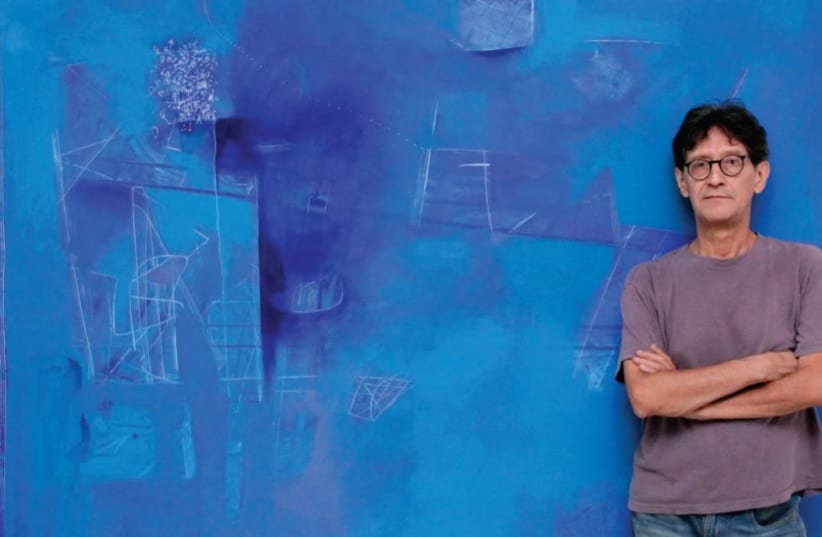So he created a painting and named it “Antibody.” At the center of it, on a bright red background (it must be blood), stands a plump, happy-looking character. It seems that he is going to win the battle and is not afraid. (The image is entirely imaginary and not based on what a Covid-fighting antibody actually looks like under a microscope.)
“He is like a superhero that you have inside you, and also in your mind and in your soul,” Guzman explains. “I try to be positive. If you are positive, you have a better chance to survive.”
Painting the coronavirus would have been too easy, he said – just a ball with spikes sticking out of it – and it would not have been a positive character. So instead, Guzman imagined the antibody.
“It was my idea to paint the new words, the new normality. As an artist, you have to catch the new words that didn’t exist,” he says. “How can you interpret the loneliness and the reflections of this time period and at the same time be positive, not pessimistic, and have a sense of humor at the same time?”
He also painted his own version of quarantine, in a work entitled “At home.” At first glance, it looks like a house with fire escapes engulfed in flames. But the flames, Guzman explains, are meant to represent the fire inside your soul.
“It’s my home, but it’s abstract. It’s the interior fire, the power of yourself,” he said. “The home is an expression of yourself. Your home represents yourself, your wishes and your dreams.”
In general, Guzman said the pandemic was a fruitful time for him as an artist, he created many works, and sold many paintings. Unlike musicians, who depend on others to play together, an artist does not need company to create – although it is a challenge to be alone and stay positive, he said.
“Everyone was alone, everyone was creating in their own space,” he said. “I’m a very social person too – normally, all the time there are exhibitions, artists meet each other. That’s the only thing that was a little boring – to not have contact with other people. It was the time to produce.”
He named another painting “The New Normality.” It is possible to look at it for a long time and see different things. It might appear, although that is up to interpretation, that two people are sitting at a table very far from one another while wearing face masks – or that the mask has fallen down to the chin of the person on the left, while the character on the right is wiping the table with a piece of cloth, maybe it is a waiter who is disinfecting the table. Or perhaps the yellow and blue colors are symbolic, maybe they represent the loneliness that each one of us faces.
“You are right in your description,” Guzman replied, when this journalist asked if she was interpreting the painting in the way that was intended.
Guzman’s other works are titled “The Challenge” (It appears to be chaotic, a battle. It is “because it’s a challenge to be alive and to be positive and to continue to create,” he said), “Internal Nature” - (a dark green depiction of water lilies at dusk, it represents a landscape inside yourself, Guzman said), and a painting with a strange name, “Floating and isolated cities” – in which boats with buildings on them appear to be floating quietly in the dark – perhaps it is a reference to closed borders?
So why is a Jewish artist in a Mexican museum – and is Ariel Guzman actually Jewish?
Guzman (who is originally from Mexico City) said that it is very likely that he has Jewish roots – but in the 14th century!
“Somebody in my family has Jewish roots, but it’s very far away,” he said. “Maybe they came from Germany, maybe they moved to Spain and then to Mexico during the conquest. In the 14th century, they started the family name.”
The name “Ariel” was given to him by his father just because it sounds nice. So it’s just a coincidence that he ended up with two Jewish names. He does not consider himself religious, he said.
But Guzman jokes that he has a Jewish soul because he traveled a lot in his life. He studied photography, animation and graphic design in Germany and interior design in Sweden, he visited Russia. He moved to the tropical city of Merida, the capital of the Yucatan state, because he loves how bright the colors are in the tropics, the light, the sun and the heat, he said. He loves that he can see palm trees from his kitchen.
Ariel Guzman recently completed his own rendition of Bluebourg (“the Blue Violinist”) by Marc Chagall. In his version, the rural scene became an imagined city, he said. The painting is a part of his series of “dialogues” with masterpieces by famous artists. He recently sold the “Mona Lisa,” he said – his own abstract version of it, that is.
“I am using the same composition, the same colors, I use the same size as the original – but I change it into an abstract work or illusion to produce fantastic cities,” he said.
The works of Ariel Guzman illustrating the pandemic were on display at the City Museum of Merida in an exhibition entitled “Visiones 2020” (“The Visions of 2020”) earlier this year. It was the first collective exhibition after eight months because everything was closed during the pandemic, Guzman said.
To learn more about the artist and to see some of his works, visit his page on Facebook
